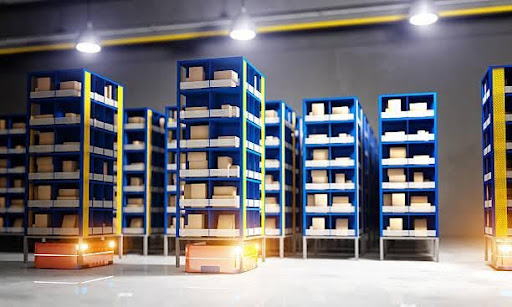Optimizing Storage and Logistics for Maximum Efficiency

Running out of space in your warehouse or distribution center can really slow things down. Many people face this problem, and most warehouses start to feel crowded after reaching 85% occupancy. This makes inventory management much harder. In this blog, you will find clear ways to improve storage capacity. We’ll talk about smart warehouse design, better inventory control systems, and helpful tools like warehouse management systems (WMS) and automated storage and retrieval systems (AS/RS). Keep reading if you want practical steps for better efficiency in your operations.
Essential Highlights
- Making aisles narrower saves up to 20% more space in warehouses. Narrow-aisle forklifts and safety measures help workers.
- Warehouse management systems (WMS) improve inventory accuracy and lower costs by guiding storage and picking.
- Using vertical space, like mezzanines or high-density racks, almost doubles warehouse capacity without needing more floor area.
- Automated tools, like robots and automated storage systems, speed up work and cut down on mistakes.
- Smart use of data helps plan better for what customers want. This keeps stock levels right and stops wasted space.
Optimize Warehouse Layout
I use warehouse design software to map out space, so I can fit more unit loads and pallets. Good warehouse optimization with very narrow aisles or push-back racking boosts storage capacity and cuts labor costs fast.
Reduce unnecessary aisle space
I save space in my warehouse by making aisles narrower. This move bumps up how much I can store by 15-20%. Here’s how I do it:
- First, I cut aisle width from 10–12 feet to 5–8 feet. This small change makes room for more products.
- I bring in equipment that works well in tight spaces. Examples include narrow-aisle forklifts and automated guided vehicles.
- Putting up mirrors and signs helps everyone move safely through these tighter spots.
- Safety gear becomes a must-have for all workers. It keeps them safe while they handle tasks in snug aisles.
- I train my team to work confidently in these new conditions. They learn to navigate with care, avoiding accidents.
- Narrowing aisles cuts down on travel time too. My team can pick and fulfill orders faster than before.
Next up, let’s talk about how using vertical storage solutions also boosts efficiency.
Utilize vertical storage solutions
Mezzanine platforms almost double warehouse floor space, especially over shipping or receiving. I make sure my racking uprights and base plates fit vertical expansion needs. A structural engineer checks load limits so columns do not block order picking lanes. ESFR sprinkler systems in new buildings let me stack items within 18 inches of the pipes, keeping fire codes tight while using more ceiling height.
Cantilever racks hold long materials like lumber or piping; forklifts can reach without trouble if aisles stay clear. High-density options such as push-back racking and drive-in racks store several pallets deep, which boosts storage capacity but might challenge first-in-first-out inventory management.
Mobile shelving closes gaps between units when not picked, cutting aisle waste by up to 50 percent. Automated storage and retrieval systems (AS/RS) support higher stacking, maintain inventory accuracy, and keep supply chain operations smooth. Next up: I use a warehouse management system to drive technology for even better efficiency.
Leverage Technology for Efficiency
I use a warehouse management system to track every item, boost inventory accuracy, and cut carrying cost—fast. Smart IoT devices and cloud-based automation let me save energy, reduce labor costs, and keep material handling smooth.
Implement warehouse management systems (WMS)
A warehouse management system (WMS) helps me track inventory in real time. I use WMS to direct put-away, which means it tells me the best spot for each pallet. This boosts space utilization and reveals underused areas fast.
My WMS standardizes tasks so workers do things one way, cutting mistakes and letting them suggest changes that work. Automated storage and retrieval systems (AS/RS), managed by my WMS, speed up picking orders while raising storage density. Key performance indicators like order fulfillment times, carrying cost, and inventory accuracy are always available on my dashboard.
I can spot slow zones or bottlenecks with just a few clicks; this lets me improve order picking decisions right away. With tools like cloud-based software, AGVs, push-back racking options, and smart material handling features built into my warehouse management system, I reduce labor costs while meeting customer satisfaction levels every day.
Integrate Internet of Things (IoT) devices
Barcode scanners and RFID tags send real-time inventory updates to my warehouse management system. These IoT tools help manage over 10,000 SKUs without errors or waste. I track space utilization every minute with connected sensors, so I spot bottlenecks fast and boost storage capacity by up to 30 percent. IoT sensors watch equipment like automated guided vehicles and alert me before breakdowns happen. With predictive maintenance in place, downtime drops by at least 20 percent each year. Smart lighting units cut energy use during off-peak hours, lowering costs while keeping safety high for everyone on the team.
Streamline Order Fulfillment Processes
Order fulfillment works best when you use automated storage and retrieval systems to save time and cut labor costs—think autonomous mobile robots or guided vehicles. Smart inventory management software keeps stock counts accurate, reduces stockouts, and helps third-party logistics move orders faster.
Improve order picking strategies
I know that improving order picking strategies is key for efficiency. It saves time and reduces mistakes.
- Place high-demand items in easily reachable areas. This cuts down on travel time.
- Use carton flow racks for items that need to go out first, like perishable goods.
- Create dedicated zones for different types of products. This makes finding items faster.
- Apply batch picking when sending out multiple orders at once. It’s a real time-saver.
- Try zone picking for large warehouses. Workers stay in one area, which speeds things up.
- Adjust pick paths to minimize distance traveled between picks. Simple changes can have big impacts.
- Use technology, like warehouse management systems, to guide pickers through the fastest routes.
- Equip pickers with handheld devices or wearables that update in real-time, reducing errors.
- Analyze past data to predict which items will be in demand and position them accordingly.
- Train staff regularly on new techniques and tools to keep improving their speed and accuracy.
I focus on these strategies because they directly impact how quickly we can get orders out the door and how accurate we are – keeping customers happy and costs low.
Use automation for repetitive tasks
Automating repetitive warehouse tasks with warehouse solutions saves time and lowers labor costs. Robots handle picking, packing, and palletizing with speed. Automated storage and retrieval systems (AS/RS) move goods between racks, cutting clutter while increasing space utilization by up to 30 percent. Conveyor belts transport orders fast across zones. Machines print pack slips and labels for thousands of daily shipments. Autonomous mobile robots (AMRs) help sort items for order fulfillment and batch picking in retail businesses. Automated guided vehicles (AGVs) safely transfer heavy pallets from dock to racks without human error.
Narrower aisles become possible since machines need less room than people; this boosts storage density by as much as 40 percent. Using automation improves inventory accuracy, reduces errors, speeds up last-mile delivery, and keeps customers happy—especially during busy online shopping days or holiday rushes.
Embrace Data-Driven Decision Making
I use warehouse management software and performance metrics to keep my work on track—fast changes come from solid information. Data gives me sharper insights, so I can spot waste and improve storage capacity with digital twins or connected sensors…
you see the difference right away.
Monitor key performance indicators (KPIs)
Tracking performance means watching key numbers daily. Every detail counts. Here is how I do it…
| KPI | What It Measures | How I Monitor | Example / Tool |
|---|---|---|---|
| Order Fulfillment Time | How fast each order ships | Check shipment timestamps | WMS dashboard, SAP, Oracle |
| Inventory Accuracy | How closely records match physical items | Use cycle counting weekly | Barcode scanners, handheld RFID |
| Employee Productivity | Units picked or packed per worker, each hour | Analyze shift reports | Labor tracking software, Shiftboard |
| Storage Utilization | Percent of space in use | Run space audits monthly | Drones, 3D mapping, in-person walkthroughs |
| Order Accuracy | Percent of correct shipments | Compare returned or corrected orders | Returns data, customer feedback in WMS |
| Backorder Rate | Percent of orders delayed by stockouts | Track open orders | WMS backlog report, ERP systems |
Tracking these KPIs helps me see trouble early. Now, I use this data for better forecasting…
Use predictive analytics for demand forecasting
I use predictive analytics to track seasonal trends and sales data. This helps me plan inventory orders to match real customer demand. Accurate forecasts stop overstocking, which causes storage problems, and prevent stockouts that hurt customer satisfaction. In 2023, I used my warehouse management system (WMS) to adjust orders during holiday seasons; this cut supply chain bottlenecks by 30 percent. Analytics tools let me rank products with ABC analysis based on how fast or valuable each item moves. For example, I store fast-moving items in easy-to-access spots for quicker order picking.
With connected devices like autonomous mobile robots (AMRs), I manage changing demand without wasting space or labor—especially during Black Friday rushes or spring surges. Strategic planning using data allows smooth scaling up when business grows and keeps costs low for third-party logistics partners too.
Conclusion
Smart storage and logistics make a clear difference. I see less waste, lower costs, and faster order fulfillment with better warehouse design and technology like WMS or AGVs. Using vertical racks, narrowing aisles to 5 feet, adding mezzanines, and choosing double-deep racking boost storage by up to 20%. Automated systems such as conveyor belts or autonomous vehicles also raise accuracy while cutting labor expenses. These steps increase productivity and keep customer satisfaction high every day.



